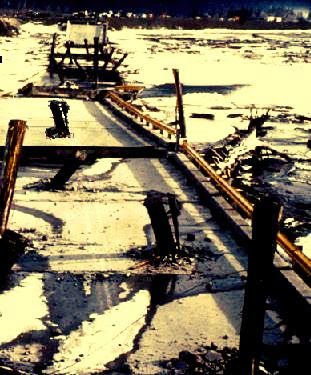During the 1964 Alaska earthquake, more than 200 bridges were damaged or destroyed by spreading of floodplain deposits toward river channels. The spreading compressed the superstructures, buckled decks, thrust stringers over abutments, and shifted and tilled abutments and piers.
This news are known to all but do we know what is lateral spreading or what is the relation between earthquake and lateral spreading. Let us try to find out the answer of above questions.
 |
In Alaska Earthquake March 27, 1964, Twentymile River Bridge fell into
the river, and some of the wood piles were driven through the reinforced
concrete deck.
|
Lateral spreads involve lateral displacement of large, surficial blocks of soil as a result of liquefaction of a subsurface layer. Displacement occurs in response to combination of gravitational forces and inertial forces generated by an earthquake. Lateral spreads generally develop on gentle slopes (most commonly less than 3 degrees) and move toward a free face such as an incised river channel. Horizontal displacements commonly range up to several meters, but where slopes are particularly favorable and ground shaking durations are long, displacements may range up to several tens of meters. The displaced ground usually breaks up internally, causing fissures, scarps, horsts, and grabens to form on the failure surface.
 |
Failure of Million Dollar Bridge on the Copper River Highway in 1964 Alaska
Earthquake
|
No comments:
Post a Comment